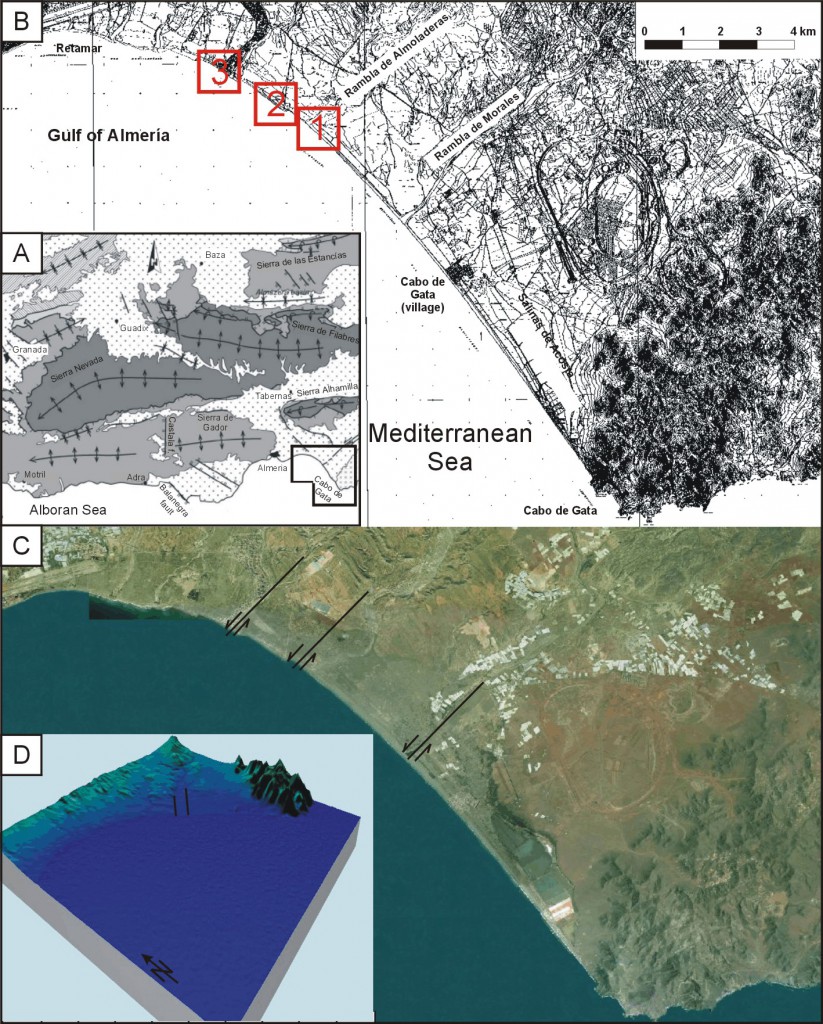This day’s Centerfault is one of the longest and best investigated faults in Spain, the sinistral Carboneras Fault Zone (CFZ) in Andalusia (36.85°N, 2.25°W). In the north, the CFZ is bounded by the Palomares fault, its southern tip reaches the Gulf of Almería. The NE-SW striking fault zone stretches over 50 km onshore and additional 100 km offshore (Gràcia et al., 2006) and is, therefore, capable of earthquakes with magnitudes > 7. It is one of the three major strike-slip faults in the Betics (Bell et al., 1997).
The fault separates the Cabo de Gata with its neogene volcanics in the SE from the internal zone of the Betic Cordillera (Nevado-Filábride and Alpujárride units) in the NW. The fault has a beautiful topographic expression (GoogleMaps data):
Sinistral offset sums up to 35-40 km, vertical offset up to 5-6 km (Montenat & Ott d’Estevou, 1995). This is really a huge amount! During Miocene, the maximum horizontal stress axis changed from NW-SE to N-S, resulting in the vertical component of the fault movement, while pure sinistral strike slip is likely to have happened before (Martínez-Díaz et al., 2004). At the southwestern shore of the Cabo de Gata peninsula, the fault offsets the shoreline:
 Here, we did ground penetrating radar for mapping the fault trace and to calculate minimum slip rates. This worked well, because there we encountered beautiful beach rock terraces:
Here, we did ground penetrating radar for mapping the fault trace and to calculate minimum slip rates. This worked well, because there we encountered beautiful beach rock terraces:
 So, it was possible to map where the fault cuts those relatively young, OIS 5e units:
So, it was possible to map where the fault cuts those relatively young, OIS 5e units:
 Here, the fault zone was definitely active during the last 125 ka, but the average slip rate seems to be less than 0.1 mm/a in that region (the fault spreads in a wide fault zone with several single strands).
Here, the fault zone was definitely active during the last 125 ka, but the average slip rate seems to be less than 0.1 mm/a in that region (the fault spreads in a wide fault zone with several single strands).
The fault has also been trenched in 2007, but the results haven’t been published yet:
 There are dozens of papers on on- and offshore seismic investigations, the clay gouges, fault separation, the Quaternary history, the slip rates, dating etc., so here are only some of them.
There are dozens of papers on on- and offshore seismic investigations, the clay gouges, fault separation, the Quaternary history, the slip rates, dating etc., so here are only some of them.
References:
- Bell, J. W., Amelung, F. & King, G. C. P. (1997). Preliminary Late Quaternary slip history of the Carboneras Fault, Southeastern Spain. J. Geodynamics 24, 1-4, 51-66.
- Gràcia E., Pallàs, R., Soto, J. I., Comas, M., Moreno, X., Masana, E., Santanach, P., Diez, S., García, M., Dañobeitia, J. & HITS scientific party (2006). Active faulting offshore SE Spain (Alboran Sea): Implications for earthquake hazard assessment in the Southern Iberian Margin. Earth and Planetary Science Letters 241, 734-749.
- Grützner, C. (2006). Georadarmessungen zur Untersuchung von
oberflächennahen aktiven Störungen in Südspanien (GPR measurements for investigating surface-near, active faults in Southern Spain), unpubl. diploma thesis, Leipzig. - Martínez-Díaz J. J. & Hernández-Enrile J. L. (2004). Neotectonics and morphotectonics of the southern Almería region (Betic Cordillera-Spain): kinematic implications. Int J Earth Sci (Geol Rundsch) (2004) 93:189 – 206.
- Montenat C. & Ott d´Estevou P. (1995): Late Neogene basins evolving in the Eastern Betic transcurrent fault zone: an illustrated review. – In: Friend P.F. & Dabrio C.J. (eds.): Tertiary basins of Spain, 372-386.
- Reicherter K. & Reiss S. (2001). The Carboneras Fault Zone (southeastern Spain) revisited with Ground Penetrating Radar – Quaternary structural styles from high-resolution images. Netherlands J of Geosci 80 (3-4):129 – 138.




No Comments
No comments yet.